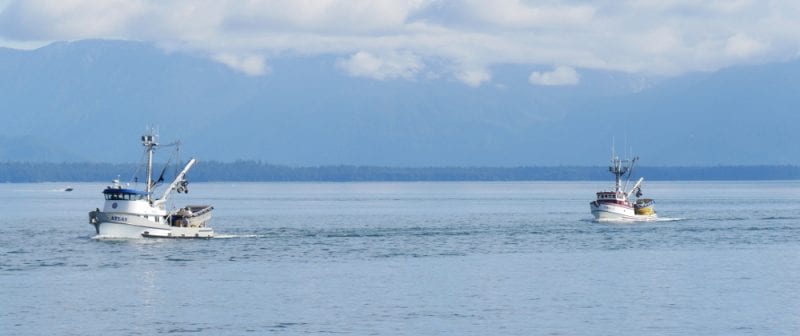
Fishing vessels Atlas and Orion head to Petersburg harbor after an opening in July of 2018. (Joe Viechnicki/KFSK)
Southeast Alaska’s commercial pink salmon catch will wind up way below forecasts, the lowest harvest in more than four decades. The Alaska Department of Fish and Game’s pink and chum salmon project leader for Southeast Andy Piston said the region’s commercial catch this summer is 7.3 million fish.
“And that would be the lowest region-wide harvest since 1976,” Piston said. “And our Southeast purse seine catch, and that’s the gear group that catches most of our pink salmon, is about 6.5 million which again is the lowest we’ve seen since the mid-1970s.”
It’s not the lowest catch ever. There were a handful of years in the 1960s and 70s with lower. The fishery is essentially over and the total catch is not expected to increase very much. This year’s harvest is well below the department’s pre-season forecast of 23 million fish. Two years ago, when the parents of this year’s run spawned, the catch was 18 million and the federal government declared a fishery disaster.
Recent even years have seen very poor returns to inside waters in northern Southeast. Managers were forecasting better runs in the southern Panhandle but those runs fell short. Piston said restrictions on fishing time did allow enough pinks to return to their spawning streams at least on the southern end.
“That’s a positive,” Piston said. “Obviously from a harvest perspective it looks poor but I guess the good thing is that we, it appears we have enough fish in our streams in southern Southeast that if survival rates turn around it gives you the potential to spring back pretty quickly. If you see a turnaround in survival you have enough eggs in the gravel that you can have a turnaround quickly.”
Fishery managers say young pink salmon are not surviving and returning to the ocean in large numbers but are not sure why. Warm ocean conditions could be a culprit, or predators eating the young pinks. An annual trawl survey done by federal scientists in northern Southeast last year recorded the lowest numbers of juvenile salmon leaving their spawning streams in 21 years of that survey. For the first time since 2007, state managers did not use that survey data to adjust their forecast. It turns out the forecast would have been closer to the actual catch if they had.
Pink salmon are targeted by the region’s purse seine fleet and are either canned or frozen. The season has wound down and many seiners are gearing up for other fisheries or calling it quits for the summer. For the most part, opportunity was limited to one-day openings because of the weak returns and many targeted chum salmon instead. The purse seine catch peaked at just over a million pinks during an opening in early August.











